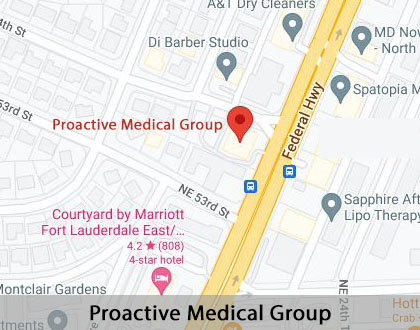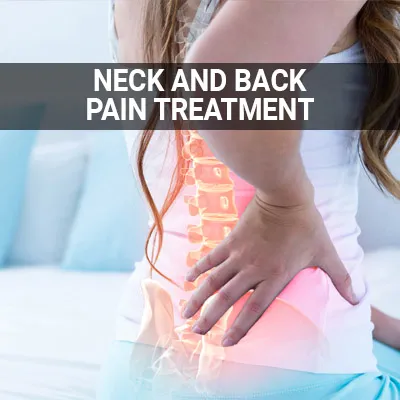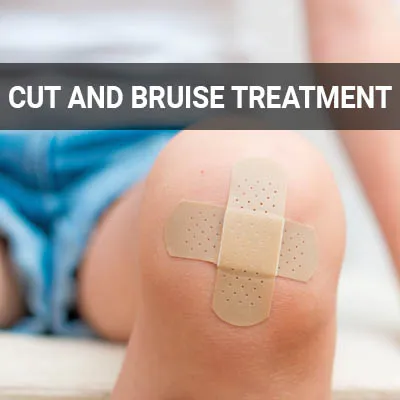Sprains and Strains Fort Lauderdale, FL
It is important to be able to distinguish between a sprain and a strain to determine the appropriate treatment and whether medical care is necessary. Although many sprains and strains are minor and may require little to no medical assistance, a primary care doctor can provide medical treatment if symptoms become severe or persist for more than a week.
While an improperly treated sprain or strain can take months to recover, receiving quality medical assistance from our primary care doctor can shorten the duration. Sprain and strain treatment is available at Proactive Medical Group in Fort Lauderdale and the surrounding area. Call us today at (954) 938-2843 to learn more about our services or schedule an appointment.
About Sprains and Strains
Although sprains and strains are common when staying physically active, there are precautionary measures one can take to minimize the risks. Sprains and strains are highly common injuries that happen predominantly during physical activity, such as sporting events, jogging, or working on an outdoor project. However, they can also occur as a result of less strenuous activity. While they are often grouped together, a sprain and a strain are two separate injuries with different symptoms, treatments, and recovery times.
Fortunately, minor sprains and strains are easy to treat by medical professionals. While a simple sprain or strain may heal on its own or only require at-home care, a more serious sprain or strain often requires a primary care doctor's guidance before the symptoms start to go away, restoring full flexibility and strength to the affected area.
“While they are often grouped together, a sprain and a strain are two separate injuries that have different symptoms, treatments, and recovery times.”
The Difference
Although people commonly mistaken sprains and strains as the same ailment, they are two separate conditions. The difference between sprains and strains is in the part of the body affected by each injury type. A sprain involves the stretching or tearing of ligaments, which are tough bands that connect bones inside joints. A strain involves the stretching or tearing of a muscle or tendon, commonly known as a muscle strain. The most common place a sprain occurs in the ankle or wrist, while a strain might take place in the hamstring, located in the back of the thigh.
With sprains, there are different classifications, or grades, that give patients a better understanding of the severity of their injury. A grade I tear is the least serious and involves a stretching or small tear of a ligament. Grade III, which is the most severe, involves the complete tearing of a ligament.
“The most common place a sprain occurs in the ankle or wrist, while a strain might take place in the hamstring, located in the back of the thigh.”
Causes of Sprains or Strains
There are numerous reasons a sprain or a strain might occur, although there are activities and lifestyle choices that may increase the risk. Although sprains and muscle strains are often unpredictable, properly warming up, using quality equipment during sports activity, and taking frequent breaks are tactics that help prevent a sprain or a strain from occurring.
The most common parts of the body affected by sprains are the ankle, wrist, and knee. Although it is often a less severe concern, the thumb is also a common place for a sprain to occur. Subsequently, activities that require heavy use of the ankle, wrist, or knee carry a higher risk of developing a sprain. For instance, exercising on an uneven surface or being confronted with a large, unexpected drop in elevation while jogging causes many to sprain their ankle. A sprained wrist most often occurs due to a fall, and knee sprains are common in athletes who are required to pivot and cut often.
Strains are different injuries, as they can occur either in an acute manner or slowly over time. An acute strain occurs when a muscle gets strained or pulled at once, causing it to stretch unusually far. Consequently, weightlifting, sports that require sprinting, and gymnastics pose a greater risk of muscle strain for participants. A more chronic strain is often the result of long-term activity and pressure to a certain area, and there usually is not a single event to point to as to why the muscle strain developed. Therefore, activities such as daily jogging, tennis, and standing for long periods of time each day can cause chronic muscle strain.
“There are numerous reasons a sprain or a strain might occur, although there are activities and lifestyle choices that may put one at an increased risk.”
Check out what others are saying about our primary care physician services on Yelp: Sprains and Strains in Fort Lauderdale, FL
Symptoms of Sprains and Strains
Since they occur during many of the same activities, sprains and strains often share several of the same symptoms, which is why they are often confused with one another. However, there are significant differences. Symptoms differ depending on where the injury occured, how severe the sprain or strain is, and the pain tolerance of the individual who suffered the injury. However, there are common symptoms that are likely to exist after most sprains and strains. According to the National Institute of Arthritis and Musculoskeletal and Skin Diseases, the most common symptoms of a sprain include pain, swelling, bruising, and the inability to use the affected joint, while symptoms of a strain may also include muscle spasms, cramping, and trouble moving the affected area.
Although just about all sprains are painful and pain is usually the first and most notable symptom, the level of pain for each strain is different depending on where the sprain occurred and the severity. While a simple, less severe ankle sprain may not be painful. While a severe high ankle sprain can cause a tremendous amount of initial pain. Additionally, there may be a popping sound when a sprain occurs, which is not the case with a muscle strain. If the sprain or strain is minor and does not exhibit serious symptoms and intolerable pain, the injury can often heal on its own with little to no medical assistance. However, more serious sprains and strains that make it difficult to walk or function properly need immediate medical assistance to ensure the injury is properly diagnosed.
“Although just about all sprains are painful and pain is usually the first and most notable symptom, the level of pain for each strain is different depending on where the sprain occurred and the severity.”
Questions Answered on This Page
Q. What are sprains and strains?
Q. What is the difference between a sprain and strain?
Q. What causes a sprain or strain?
Q. What are the symptoms of sprains and strains?
Q. Who do doctors treat sprains and strains?
People Also Ask
Q. What treatments are available for back pain?
Treating Sprains and Strains
Our primary care doctor can quickly treat sprains and strains, regardless of the severity. The first thing we often do is confirm the diagnosis. In many instances, the best way to do so is to check a patient's symptoms. A primary care doctor will check the affected area to identify the injured muscle or ligament, while also documenting symptoms and pain level. In some instances, an X-ray may be necessary to confirm there are no broken bones.
For most minor sprains and strains, the best course of treatment may be to apply the R.I.C.E. method of recovery, which stands for rest, ice, compression, and elevation. After several weeks of proper rest (limiting pressure on the affected area), the application of ice to the affected area several times a day, compression with a wrapped bandage, and elevation of the affected area, the sprain or strain should heal. For more serious sprains, such as a high ankle sprain or strained hamstring, a splint or brace may be needed to ensure the affected area receives proper rest. Physical therapy may also be necessary for some patients. If the ligament is completely torn due to a sprain or the muscle ruptures after a strain, a surgical procedure may be in order. Most commonly, surgery is applied to athletes who injure their ACL (anterior cruciate ligament) in their knee.
For recovery, the medical professional may suggest pain relief medication to help cope with the pain, especially if a therapy session is required. Anti-inflammatory medication also helps reduce the amount of swelling that often results from a sprain or strain.
“For most minor sprains and strains, the best course of treatment may be to apply the R.I.C.E. method of recovery, which stands for rest, ice, compression, and elevation.”
Frequently Asked Questions
Q. What causes a sprain or a strain?
A. A sprain often involves an injury that moves a joint too far in either direction, such as falling and landing on your hand, which can cause a wrist sprain. Also, a blow to the body that causes the ankle to twist and turn can lead to an ankle sprain. For strains, the most common cause is overuse, which leads to a chronic strain. An acute strain happens suddenly, and it is most often caused by a blow to the body or overstretching, which is common in weightlifting, sprinting and sport activities.
Q. I want to recover from my sprain or strain as quickly as possible so I can return to playing my sport. How do I speed up the recovery process?
A. The best way to speed up the recovery process after a sprain or strain is to implement the R.I.C.E. method, which involves resting, icing, compressing and elevating the affected area. Additionally, it is important to seek medical assistance as soon after the injury as possible for proper diagnosis in treatment, especially when attempting to make a fast recovery. Most importantly, resist the urge to return to what caused the injury (e.g., sports, running, etc.) until a full recovery is made.
Q. I have been trying to stay active despite my sprain or strain, and it has not gotten any better. Is there any way I can stay active with a sprain or a strain?
A. The short answer is no. The only way to truly recover from a sprain or a strain is to rest and properly apply the treatment necessary. It is important to be patient with a sprain or strain, as there is a high chance of re-injury if it is not properly rested. With that said, you may be able to alter the way you practice, especially while playing sports. If you endure an ankle sprain while playing basketball, perhaps find an area of practice that does not involve any use of the affected area, such as shooting baskets in a chair.
Q. How long does it take to fully recover from a sprain or a strain?
A. The time it takes to make a full recovery from a sprain or strain depends on the severity of the injury. If you suffer from a grade I sprain, it typically heals within one to two weeks after the injury, assuming proper rest and treatment is administered. For grade II sprains and strains, it often takes four to six weeks to make a full recovery. For grade III strains, which typically involve a tear, it can take more than 12 weeks to make a full recovery. Keep in mind that every injury is different, and the exact recovery time depends on various factors that are hard to predict.
Q. Is there anything I can do to prevent a sprain or strain from occurring?
A. There are several steps you can take to prevent a sprain or strain from occurring, although the risk is always there during physical activity. To give yourself the best chance possible to prevent a sprain or strain, be sure to conduct a warm-up activity, and then go through a thorough stretching routine. There are also braces (for joints) or compression sleeves (for muscles) for particular areas to provide more stability and safety of that area. Keep in mind, it is important to warm up the body before stretching.
Start Feeling Better – Visit Us Today
By visiting us as soon as possible, our team can help get you the professional treatment you need. Instead of waiting around and allowing the symptoms to get worse, we can provide you with treatment options.
Definition of Medical Terminology
Call Us Today
A primary care doctor can ensure your sprain or strain is properly dealt with in an effective and efficient manner. Our team at Proactive Medical Group can treat sprains and strains of varying severity. Do not hesitate to give us a call at 954-938-2843 for any questions or to schedule an appointment.
Helpful Related Links
- American Assocation of Neuromuscular and Electrodiagnostic Medicine. American Assocation of Neuromuscular and Electrodiagnostic Medicine. 2023
- American Journal of Medicine. American Journal of Medicine. 2023
- American Medical Association (AMA). American Medical Association (AMA). 2023
- American Trauma Society. American Trauma Society. 2023
- Journal of the American Podiatric Medical Association. Journal of the American Podiatric Medical Association. 2023
- National Council on Aging. National Council on Aging. 2023
- National Spine Health Association. National Spine Health Association. 2023
- The National Institute for Occupational Safety and Health (NIOSH). The National Institute for Occupational Safety and Health (NIOSH). 2023
- United States Department of Labor OSHA. United States Department of Labor OSHA. 2023
About our business and website security
- Proactive Medical Group was established in 2022.
- We accept the following payment methods: American Express, Cash, Check, Discover, MasterCard, and Visa
- We serve patients from the following counties: Broward County
- We serve patients from the following cities: Fort Lauderdale, Oakland Park, Wilton Manors, Pompano Beach, and Sea Ranch Lakes
- Norton Safe Web. View Details
- Trend Micro Site Safety Center. View Details
Back to top of Sprains and Strains










